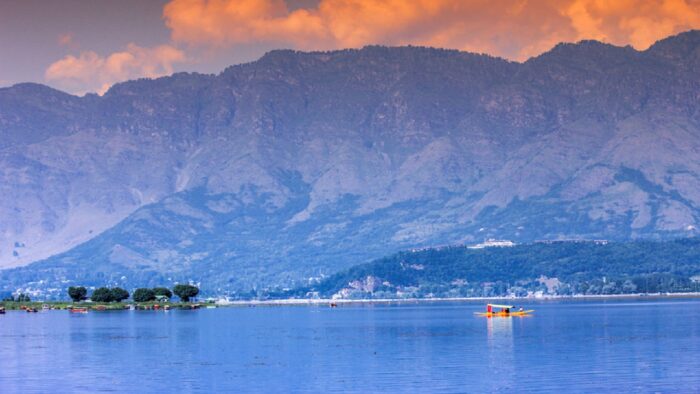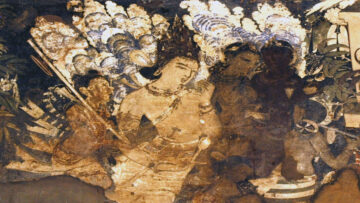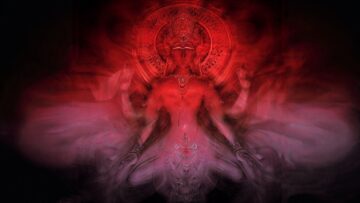While describing the land of Kashmir, the tenth century Kashmiri saint and polymath, Ācārya Abhinavagupta, went into bouts of ecstasy, describing it as the place ‘where yogis and munis dwell in various spots, where Śiva himself dwells all the time’. He states emphatically that there is no other place in the world, such as Kashmir, for the fulfilment of all wishes and for the attainment of yogic accomplishments. He goes on to describe the beauty of Kashmir in his magnus opus, Tantraloka, describing the moon, the seasons, the various people, all the while diffusing them with divine imagery. He even defines Kashmir’s glory through its societal settings, emphasizing the fact that Kashmir was that land ‘where people normally are poetic and wise, where even the warriors are articulate, where women of cities are lustrous as the moon and charming in gait and where yoginis steeped in the spiritual achievements abound’ [1]. It is clear from this fascinating description that Kashmir far from being an ordinary place, was the perfect setting for the evolution of the ‘darśana’ (philosophical framework and its associated praxis) that we now call Kashmir Shaivism.
A debate rages behind the closed doors of academic institutions, in the private chats of peers and in some published works, on the coinage and the legacy of the term – Kashmir Shaivism. Many argue that that term is antiquated and irrelevant [2]. The reasons they state are centred around two themes, the first regarding the implication of using a geographical location to limit the larger scope of the darśana, and second regarding the usage of ‘Shaivism’ to denote a specific type of sectarian philosophy. This article addresses both these themes and attempts to make a case for the use of Kashmir Shaivism as a justifiable term in reference to TrikaDarśana or Paramādvaitadarśana.
Origins of the term
The earliest known reference to this darśana as ‘Kashmir Shaivism’ comes from J Chatterji’s book, by the same name, first published in 1914[3]. The ease of the term combined with its inherent modernity, made the term quite appealing to the English-speaking academic audience of the time. They accepted it wholeheartedly (we do not know if early debates existed) and before long, the term because ubiquitous. Papers, conferences, studies etc. all started to use ‘Kashmir Shaivism’ to refer to Trikadarśana and as an umbrella term referring to the sub-traditions of Kula, Krama, Spanda and Pratyabhijna schools [4]. That fact that Ācārya Abhinavagupta integrated all the sub-systems in his vision of the larger meta-framework of Anuttara Trika (where the Highest principle is described as ‘Parabhairava’) helped scholars to think of it as a ‘Shaivite’ system completely integrating the principle of ‘Śakti’.
The Geographical Rooting of Shaiva Transmission and Exegesis
In a Hindi radio interview given by Swami Lakshmanjoo, the great scholar-saint of Kashmir, he answers a very directed question by the interviewer as to why ‘Kashmir’ is used in reference to the Trikadarśana. He goes on to explain the Guru Krama (the lineage of masters), from Śrīkaṇṭhanātha onwards, who is believed to have manifested in Kailash Mountain in the Himalayas in the beginning of the Kali Yuga. The insiders of this tradition say that this lineage eventually shifted exclusively to Kashmir. Swamiji describes this migration as follows: “Saṅgamāditya came from Kailash Parbat to Kashmir. His lineage continued in Kashmir. Also, Atrigupta came to Kashmir and was accommodated here during the time of RājaLalitāditya. His expertise was also brought into the religious landscape of Shaivism in Kashmir. Abhinavagupta was in his lineage as well”[5]. Swamiji reasons out that since all the key contributors of Kashmir Shaivism lived as Kashmiris in body and spirit, starting with Saṅgamāditya, it should be called Kashmir Shaivism[6]. The parallel transmission of the Śiva Sutras through Ācārya Vasugupta is also rooted in the land of Kashmir[7]. Unlike any other darśana before or since, Kashmir alone became the fertile land where the seeds of this darśana, gathering nourishing elements from the various existing systems across Bharat, reached its spiritual-philosophical culmination at the time of Ācārya Abhinavagupta. Thus, the story of Trikadarśana is intimately linked to its lineage of siddhas and its geographical setting, Kashmir.
Rooting the darśana in Kashmir need not be a limitation as many argue. It doesn’t mean that this system is practiced only in Kashmir and nowhere else in Bharat or the world. It simply implies that Kashmir Shaivism can be viewed as a darśana that was gifted to the whole world by Kashmir and its people, and now it belongs to humanity as a whole. Just as how the theories that come to be attached to individual’s names (Newton’s Theory of Motion, Pythagoras Theorem etc.), do not in any way mean that it applies to that person alone, Kashmir Shaivism is not specific to Kashmir alone, but belongs to all those who embrace it.
The Aesthetic-Experiential Influence of Kashmir on Trika Darśana
This article began with a reference to the glowing tributes of Ācārya Abhinavagupta to Kashmir, as both a divine land and a divine society. This is certainly no accident. In his monumental work “Abhinavabhārati”, we see Ācārya’s vision of the nature of aesthetic beauty being described, while secretly and subtly weaving in the larger framework of his spiritual insights. The opposite is the case with his magnus opus ‘Tantraloka’ where he attempts to capture the subtle element of ‘rasa’ (aesthetic-pleasure) in his verses, while dealing with terse matters of ritual and philosophy[1]. One could ask if this could possibly be done in, say a harsh desert landscape or the deserted mountain caves in the upper Himalayas? The answer is most certainly ’No.’ The land and its people, play a significant role in the way the thought process of a civilization unfolds. The aesthetic beauty of the stunning Kashmir valley with its forests, its clear water bodies, set against the backdrop of the mesmerising blue mountains, illumined by the snow, shining in the clear morning sun; if poets and saints could ever be created, it could only be in such an enthralling space. Ācārya Utpaladeva, the great Pratyabhijna philosopher-poet is said to have gone into divine trances in the midst of the Dal Lake, singing verses in praise of his beloved Śiva. These were later compiled and came to be known as Śiva Stotrāvali[8]. Here too we see the aesthetic-experiential influence of the landscape of Kashmir in the development of the darśana.
The Kashmir Exodus and Its Hefty price
During the early months of 1990, the last phase of the Kashmir exodus began in response to the genocidal forces taking charge in Kashmir. The Kashmiri families leaving their home and hearth, packed what is most important to them in the dead of the night, and onboarded any means of transport they could find to flee before day-break. One would expect an ordinary man to perhaps carry his clothes and valuables when he decides to leave his home for good in the midst of a life-threatening crisis. However, the gentle yet sterling character of the people of Kashmir, inspired them to travel with something even more valuable to them – Knowledge. Books, puja manuals, old manuscripts handed over to them from earlier generations, made it out of Kashmir, safe in the hands of Kashmiris who prized them more than their own life. While most of the published texts are available in the KSTS series (Kashmir Series of Texts and Studies), many new manuscripts have come to light over time, thanks to the incredible bravery of the Kashmiri Pandits. These manuscripts are now available in portals like eGangotri[9]. The coinage and usage of Kashmir Shaivism as a term is also a glowing tribute to this brave community, one that the rest of Bharat owes them.
Academic Sleight of Hand
In his book Tantra Illuminated, Dr Christopher Wallis, makes some interesting comments about Hinduism. He states that it is a misunderstanding to consider Shaivism and Tantra to be part of “Hindu”ism, which is a colonial construct. He argues that prior to the colonial era, no clear reference of a common unified religion known as Hinduism exists, but what was there instead were a set of mutually distinct religious traditions like Brāhmanism (a.k.a. Vedism), Śaivism, Śāktism, Vaiṣhṇavism, Buddhism, and Jainism. He also argues that Hinduism as a religious framework tends to blur the separation of these various traditions but integrating it within a larger framework of Vedic Brāhmanism[10].
In short, Dr Wallis argues that Shaivism and specifically Trika Shaivism (which he refers to with its technical name as ŚaivaŚakta Tantra) is falsely clubbed under the framework of Hinduism. He is not alone in promoting this rhetoric of dismissing the existence of an ancient meta-system (one may call it Sanatana Dharma) that existed long before the word “Hindu” even came to be. This meta-system accommodated within it the various varieties of Indic traditions as darśanas, with an attitude of “samanvayata” ie. celebrating diversity firmly rooted in a foundational unity based on a civilizational consciousness [11]. Therefore, any attempt to separate out Kashmir Shaivism or ŚaivaŚakta Tantra from the larger body of Sanatana Dharma is a misguided effort and cannot be accurate in its assessment. The coinage of the term Kashmir Shaivism, being rooted in Kashmir, helps to resist these misguided attempts.
Śaivism, Śaktism or No-ism
The ‘Shaiva’ part of Kashmir Shaivism is often argued to be a sectarian term. Some scholars argue that Trika is neither Shaiva nor Shakta exclusively. While this is true, the ‘Shaivism’ part of the term does not imply an exclusion of Śakti as is suggested in their arguments. What can technically be called the ‘Śaiva Mantra Marga’ forms the foundational basis for clarifying how Kashmir Shaivism is an act of Śaiva-Śākta integration[12]. Here we see the broadening of the definition of Shaivism, as a darśana, concerning that ‘Śiva’, who is Universal Consciousness (Chaitanya)[13], which is well beyond the confines of any name, form and its corresponding puranic implications. The Śiva Mantra Marga integrates within the ideal of Supreme Consciousness, known within the tradition as Bhairava, the form and essence of Śakti (as Power) thus enabling the various seers of the lineage to use the terms Śiva and Śakti in context, while qualifying it with the fact that there is no difference between Śakti and Śaktimān (Śiva)[14]. Therefore, when the term Śiva or Shaiva is used, Śakti is implied and vice versa. This distinguishes Kashmir Shaivism from other exclusive Shaivite systems like Śaiva Siddhanta and Śākta systems like Śri Vidya, where either the Śiva or Śakti tattvas are considered higher than the other. Since a student of Kashmir Shaivism is taught the eternal union or sameness of the Śiva and Śakti aspects, no real harm is done in calling it ‘Shaivism’.
Moreover, within the Śastric tradition itself, Ācārya Somananda in his work ‘Śivadristi’ argues that it would be proper to call the ‘person’ (consciousness as the first person) using only the term ‘Śiva’ according to rules of Sanskrit grammar. Even then it must be emphasized that Śiva’s Śakti is absolutely one with Him and that if Śakti as a term is used in reference to the same entity, it would be fine [15].
In summary, the term Kashmir Shaivism, despite the resistance of many, can still hold relevance today as perhaps one of several terms referring to the same darśana. It is true that Trikadarśana was not restricted to Kashmir alone nor did it develop in isolation from other parts of Bharat and other darśanas. However, as argued in the article, both in terms of its rootedness in the geography of Kashmir as well as the uniqueness as a system of Shaiva thought and praxis, we are justified in continuing to use this term now and in the future.
References
[1] Verses 40-46,Tantraloka Ch37,ABHINAVAGUPTA’S SRI TANTRALOKA AND OTHER WORKS, First Time English Translation with Sanskrit Texts, Volume 8 by Prof. Satya Prakash Singh & Swami Maheswarananda
https://archive.org/details/in.ernet.dli.2015.344996
[2] Page 333-335, TantraIlluminated by Christopher D. Wallis.
[3] Kashmir Shaivism, Jagdish Chandra Chatterji, https://archive.org/details/kashmirshaivismjagadishchandrachatterjikss_202003_692_i/mode/2up
[4] Page 129, Kashmir Shaivism-The Secret Supreme, Swami Lakshmanjoo
[5] https://archive.org/details/swami-lakshman-joo-hindi-interview-track-1_81_g
[6] Page 112, Kashmir Shaivism-The Secret Supreme, Swami Lakshmanjoo
[7] Page 9-10, Śiva Sutras- The Supreme Awakening, Swami Lakshmanjoo
[8] “The captivating verses that comprise our newest publication, Festival of Devotion & Praise were born on Kashmir Valley’s picturesque Dal Lake as an inspirational outpouring of devotion from the heart of the medieval Kashmiri spiritual master and mystic Utpaladeva.”
https://www.lakshmanjooacademy.org/kashmir-shaivism/teachings/Śivastotravali/
[9]https://archive.org/search?query=sharada%20eGangotri
[10] Page no 39-41, TantraIlluminated by Christopher D. Wallis.
[11] https://swarajyamag.com/magazine/a-space-for-differences-samanvaya , article by Aravindan Neelakandan
[12] https://en.wikipedia.org/wiki/Mantra_marga
[13] Sutra 1.1, Śiva Sutras- The Supreme Awakening, Swami Lakshmanjoo
[14] Verse 68, TantralokaAhnika 1, (Light on Tantra in Kashmir Shaivism, Swami Lakshmanjoo)https://www.lakshmanjooacademy.org/the-aspects-of-lord-Śiva-svatantrya-Śakti-in-kashmir-shaivism/
[15] Page 212-214, The Ubiquitous Siva, John Nemec
Feature Image Credit: dreamstime.com
Disclaimer: The opinions expressed in this article belong to the author. Indic Today is neither responsible nor liable for the accuracy, completeness, suitability, or validity of any information in the article.









